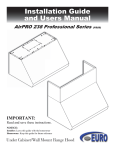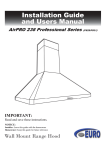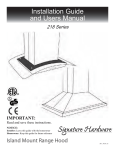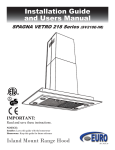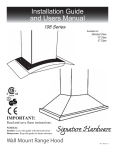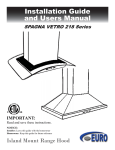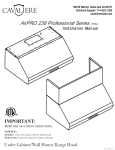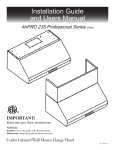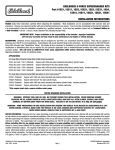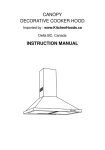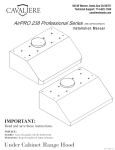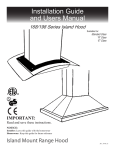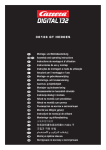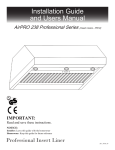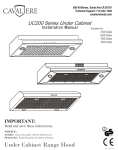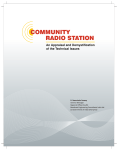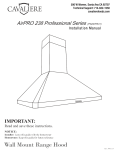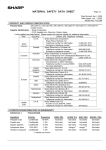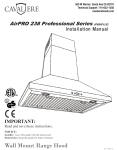Download Arietta 30 in. Wall Mount Decorative Range Hood Dekor Glass 30 - PS01
Transcript
Installation Guide and andUsers UsersManual Manual IMPORTANT: Read and save these instructions. NOTICE: Professional Series Installer: Leave this guide with the homeowner Homeowner: Keep this guide for future reference Under Cabinet/Wall Mount Range Hood (PS0l) Important Safety Notice Read all Instructions before Installing and operating this appliance • • • • • The installation in this manual is intended for qualified installers, service technicians or persons with similar qualified background. Installation and electrical wiring must be done by qualified professionals and in accordance with all applicable codes and standards, including fire-rated construction. DO NOT attempt to install this appliance yourself. Injury could result from installing the unit due to lack of appropriate electrical and technical background. Range hood may have very sharp edges; please wear protective gloves if it is necessary to remove any parts for installing, cleaning or servicing. Activating any switch ON before completing installation may cause ignition or an explosion. Due to the size and weight of this range hood, two people installation is recommended. Installation Guide and Users Manual To reduce the risk of fire, electric shock, or injury to persons: • • • • • • • • • • • • For general ventilating use only. DO NOT use to exhaust hazardous or explosive materials and vapors. The combustion air flow needed for safe operation of fuel-burning equipment may be affected by this unit’s operation. Follow the heating equipment manufacturer’s guideline and safety standards such as those published by the National Fire Protection Association (NFPA), and the American Society of Heating, Refrigeration and Air Conditioning Engineers (ASHRAE), and the local code authorities. Before servicing or cleaning unit, switch power OFF at service panel and lock service panel to prevent power from being switched ON accidentally. Clean grease laden surfaces frequently. To reduce the risk of fire and to disperse air properly, make sure to vent air outside. DO NOT vent exhaust into spaces between walls, crawl spaces, ceiling, attics or garages. Ducted fans MUST always be vented to the outdoors. Use only metal ductwork and this unit MUST be grounded. Sufficient air is needed for proper combustion and exhausting of gases through the duct to prevent back drafting. When cutting or drilling into wall or ceiling, be careful not to damage electrical wiring or other hidden utilities. All electrical wiring must be properly installed, insulated and grounded. Old duct work should be cleaned or replaced if necessary to avoid the possibility of a grease fire. Check all joints on duct work to insure proper connection and all joints should be properly taped. Use this unit only in the manner intended by the manufacturer. If you have questions, contact the vendor. To reduce the risk of a stove top grease fire: • • • • Keep all fan, baffle, spaces, filter, grease tunnel, oil container and grease-laden surfaces clean. Grease should not be allowed to accumulate on fan, baffle, spaces, filter, grease tunnel and oil container. Always turn range hood ON when cooking at high heat or when cooking flaming foods. Use high settings on cooking range only when necessary. Never leave surface units unattended at high settings. Boil overs cause smoking and greasy spillovers that may ignite. Heat oils slowly on low or medium settings. Page 1 Important Safety Notice Read all Instructions before Installing and operating this appliance • • • Clean ventilating fan frequently. Always use appropriate cookware and utensils size. Always use cookware appropriate for the size of the surface element. To reduce the risk of injury to persons in the event of a stove top grease fire: • • • SMOTHER FLAMES with a close-fitting lid, cookie sheet, or metal tray, then turn OFF the burner. BECAREFUL TO PREVENT BURNS. NEVER PICK UP A FLAMING PAN—you may be burned. KEEP FLAMMABLE OR COMBUSTIBLE MATERIAL AWAY FROM FLAMES. If the flames DO NOT go out immediately, EVACUATE AND CALL THE FIRE DEPARTMENT . DO NOT USE WATER, including wet dishcloths or towels — a violent steam explosion will result. Use an extinguisher ONLY if: • You know you have a Class A, B, C extinguisher, and you already know how to operate it. • The fire is small and contained in the area where it is started. • The fire department is being called. • You can fight the fire with your back to an exit. To reduce the risk of injury to persons in the event of a gas leaks: • • • Extinguish any open flame. DO NOT turn on the lights or any type of appliance. Open all doors and windows to disperse the gas. If you still smell gas, call the gas company and fire department. Your safety and the safety of others is very important. We have provided many important safety messages in this manual and on your appliance. Always read and obey all safety messages. All safety messages will tell you what the potential hazard is, tell you how to reduce the chance of injury, and tell you what can happen if the instructions are not followed. WARNING This is the safety alert symbol. This symbol alerts you to potential hazards that can hurt you and others. All safety messages will follow the safety alert symbol and the word “WARNING”. Page 2 Parts supplied: Under Cabinet Range Hood Qty: 4 PCS Single-piece Chimney (Optional) Qty: 4 PCS (For sheet rock only) Hood-mounting Bracket (Qty: 2PCS) Ducting Transition Qty: 8 PCS (Flat head) Optional for Single-piece Chiomney Qty: 10 PCS (Round head) Qty: 8 PCS Baffle Filters Qty: 8 PCS Baffle Filter Spacer Qty: 8 PCS Grease Tunnel Page 4 Venting Requirements • • • • • • • Height & Clearance Vent system must terminate to the outside (roof or side wall). DO NOT terminate the vent system in an attic or other enclosed area. DO NOT use 4” (10.2 cm) laundry-type wall caps. Use metal/aluminum vent only. Rigid metal/ aluminum vent is recommended. DO NOT use plastic vent. Always keep the duct clean to ensure proper airflow. Calculate the following figures before installation: 1. Distance from the floor to the ceiling. 2. Distance between the floor to the countertop/stove (recommend* 27” to 30”). 3. Distance between the countertop/stove to the range hood. 4. Height of hood and duct cover. Cabinet Height Range Hood Height Under Cabinet Range hood For the most efficient & quiet operation: • • • • • • • • • • A distance of 27” to 30” is recommended* between stove top and the bottom of range hood. It is recommended that the range hood be vented vertically through the roof through 8” (17.8 cm) or bigger round metal/aluminum vent work. The size of the vent should be uniform. Use no more than three 90° elbows. Make sure there is a minimum of 24” (61 cm) of straight vent between the elbows if more than one elbow is used. DO NOT install two elbows together. The length of vent system and number of elbows should be kept to a minimum to provide efficient performance. The vent system must have a damper. If roof or wall cap has a damper, DO NOT use damper (if supplied) on top of the range hood. Use silver tape or duct tape to seal all joints in the vent system. Use caulking to seal exterior wall or roof opening around the cap. * Due to different ceiling height configurations, recommended height may not be applicable. Cabinet or Singlepiece Chimney (Optional) Min: 27” Max: 30” Ceiling Height Countertop/Stove 36” Counter Top Page 5 IMPORTANT: • A minimum of 8” round (standard for this range hood) or 3-1/4 x 10” rectangular duct (purchased separately) must be used to maintain maximum airflow efficiency. • Always use rigid type metal/aluminum ducts if available to maximize airflow when connecting to provided duct. • Please use Duct Run Calculation below to compute total available duct run when using elbows, transitions and caps. • ALWAYS, when possible, reduce the number or transitions and turns. If long duct run is required, increase duct size from 8” to 9” or 10”. If a reducer is used, install a long reducer instead of a pancake reducer. Reducing duct size will restrict airflow and decrease airflow, thus reduce duct size as far away from opening as possible. • If turns or transitions are required: Install as far away from opening and as far apart, between 2, as possible. • Minimum mount height between stove top to hood bottom should be no less than 27-inch*. • Maximum mount height between stove top to hood bottom should be no higher than 30-inch*. • It is important to install the hood at the proper mounting height. Hoods mounted too low could result in heat damage and fire hazard; while hoods mounted too high will be hard to reach and will loose its performance and efficiency. • If available, also refer to stove top manufacturer’s height clearance requirements and recommended hood mounting height above range. * Due to different ceiling height configurations, recommended height may not be applicable. Minimum Duct Size: • Round - 8” minimum • Rectangular - 3-1/4 x 10” minimum (requires a 8” to 3-1/4x10” adaptor, not supplied) Calculating Vent System Length To calculate the length of the system you need, deduct the equivalent feet for each vent piece used in the system from the recommended maximum duct run. Duct Run Calculation: Recommended maximum run 8” or 3-1/4 x 10” duct 50 ft Duct Run Calcuation example: One roof cap, two 90º elbow, and one 45º elbow used: 0ft + 9ft + 9ft + 5ft = 23ft used. Vent piece deduction Each 90º elbow used 9 ft Deduct 23ft from 50ft, 27ft maximum available for Each 45º elbow used 5 ft straight duct run. Each 8” to 3/14 x 10” transition used 7 ft Side wall cap with damper 0 ft Roof cap 0 ft Page 6 Venting Methods • • This range hood is factory set for venting through the roof or wall. Vent work can terminate either through the roof or wall. To vent through a wall, a 90° elbow is needed. IMPORTANT: • • • • NEVER exhaust air or terminate duct work into spaces between walls, crawl spaces, ceiling, attics or garages. All exhaust must be ducted to the outside. Use metal/aluminum duct work only. Fasten all connections with sheet metal screws and tape all joints with certified Silver Tape or Duct Tape. Use caulking to seal exterior wall or roof opening around the cap. Horizontal wall venting Option 1: Option 2: Side wall cap Vertical roof venting Roof cap Page 7 Electrical Requirements IMPORTANT: Observe all governing codes and ordinances. It is the customer’s responsibility: • To contact a qualified electrical installer. If codes permit and a separate ground wire is used, it is recommended that a qualified electrician determine that the ground path is adequate. A 120-Volt, 60 Hz, AC-only, fused electrical supply is required on a separate 15-amp circuit, fused on both sides of the line. DO NOT ground to a gas pipe. Check with a qualified electrician if you are not sure that the range hood is properly grounded. DO NOT have a fuse in the neutral or ground circuit. IMPORTANT: Save this Installation Guide for electrical inspector’s use. Page 8 Preparation Advanced Preparations: • Be familiar with the controls of the range hood by reading through Range Hood Operations, Page 12. • Place the range hood on a flat, stable surface. Connect the range hood to a designated standard outlet (120-Volt, 60Hz, AC only) and turn on the range hood. Verify all operations of the range hood by referring to Range Hood Operations Page 13. • Place all supplied parts and required hardware on a flat, stable surface and verify the existence of all supplied parts listed on Page 4. • Carefully remove the white plastic protective coat from the range hood. Preparations: NOTE: To avoid damage to your hood, prevent debris from entering the vent opening. • • • • • • • Decide the location of the venting pipe from the hood to the outside. Refer to Venting Methods on Page 7. A straight, short vent run will allow the hood to perform more efficiently. Try to avoid as many transitions, elbows, and long run as possible. This may reduce the performance of the hood. IMPORTANT: Peel white plastic protective coat off the hood, if any. Use silver tape or duct tape to seal joints between pipe sections. For installing under the cabinet with recessed bottom, attach 4-inch wide wood filler strips (not provided) on each side. Refer to Figure 1. Using references in Measurements and Diagrams on Page 16, create access opening for electrical wires and hood exhaust under the cabinet. CAUTION: If moving the cooking range is necessary to install the hood, turn OFF the power on an electric range at the main electrical box. SHUT OFF THE GAS BEFORE MOVING A GAS RANGE. • • • Puncture the knockout holes (for mounting under the cabinet) on the hood as shown in Figure 2. If necessary, attach two rubber stands with 3M adhesive tapes to the back corners of the hood. Attach ducting transition to hood exhaust with included 10 round head screws as shown in Figure 3. Figure 1 Figure 2 Figure 3 Page 9 Installation I t ll ti Installations (refer ( f tto P Page 4 ffor parts): 1. Measure the distance between stove top and the bottom of range hood. A distance of 27” to 30” is recommended*. *Due to different ceiling height configurations, recommended height may not be applicable. 1. You have two ways (A or B) to mount this range hood: A–1. Proceed if you would like to mount this range hood without using the hood-mounting bracket. A–2. Using references in Height & Clearance on Page 5 and Measurements and Diagrams on Page 16, center the hood beneath the cabinet and flush with the front of the cabinet. A–3. Draw electrical wires through cabinet access opening, center the hood beneath the cabinet as shown in Figure 4. A–4. From inside of the hood, place screws into the exact center of each knockout hole and secure to cabinet bottom. Finish tightening all screws until secure. Be careful when using electrical screwdriver, damage to the range hood may occur. Skip Part B below and proceed to Step 2. CAUTION: Make certain the range hood is secure before releasing! B–1. Proceed if you would like to mount this range hood using the provided hood-mounting bracket. B–2. Using references in Height & Clearance on Page 5 and Measurements and Diagrams on Page 17, mark the leveling point of the hood. Position two mounting screws on the wall, leaving 1/8” space away from the wall. Mounting the hood on wall studs or lumbars is highly recommended. B–3. Punchure the knockout wire access hole at the back of the hood and draw the electrical wires through as shown in Figure 4. B–4. Attach each hood-mounting bracket to the back of the hood with 4 flat head screws as shown in Figure 5. B–5. Align hood-mounting bracket to the screws on the wall and hook hood into place as shown in Figure 6. Tighten screws to secure hood to the wall. CAUTION: Make certain the range hood is secure before releasing! 2. For safety purpose, pre-drilled mounting holes are provided through the back of the hood. For a more secure installation, use as many mounting holes as needed to secure from the inside of hood. 3. Use 8” round steel pipe (follow building codes in your area) to connect the exhaust on the hood to the ductwork above. Use silver tape or duct tape to make all joints secure and air tight. Refer to Figure 7. SAFETY WARNING: Risk of electrical shock. this range hood must be properly grounded. Make sure this is done by qualified electrician in accordance with all applicable national and local electrical codes. Before connecting wires, switch power off at service panel and lock service panel to prevent power from being switched on accidentally. 4. Connect the range hood to a designated standard outlet (120-Volt, 60Hz, AC only) or cut off the plug and connect three wires (black, white and green) to house wires and cap with wire connectors. Connect according to colors (i.e. black to black, white to white, and green to green) as shown in Figure 8. Figure 4 Figure 5 Figure 6 Page 10 Installation (Continued) 5. 6. 7. 8. Store excess wires in the wiring box. OPTIONAL: If you purchased a single-piece chimney cover, attach it to the hood in this step. Drop oil tunnel into recess support near rear of hood. Refer to Figure 9. To install baffle filters and stainless spacer(s), refer to Baffle Filters and Stainless Steel Spacers on Page 18 for baffle filter and stainless spacer placement. Refer to Figure 10 for the following five steps: Angle baffle filter toward back of hood. Push baffle filter up until almost level. Slide forward into recess behind the front of hood. Lower baffle filter. Slide back until it fits into resting positions. 9. Repeat Step 8 to install all baffle filters and stainless spacers. 10. OPTIONAL: Install heating lamps (not included) last. 120-Volt, 250-Watt maximum per lamp. 11. Turn powe ON in control panel. Check all lights and fan operations. 12. Make sure to leave this Installation Guide for the homeowner. Figure 10 Figure 7 Figure 8 Figure 9 Page 11 Range Range The range hood will start on Low speed.Each gently touch of the Speed Control button will cycle through the various speeds. Troubleshooting 1. If the range hood or halogen light does not operate after installation: • • Check if the range hood has been plugged in, make sure that all power has been turned back ON, fused not blown and all electrical wiring are properly connected. Swap out light assembly to working ones to determine whether it is caused by defective bulbs. See Replacing the light bulbs on Page 23. 2. The range hood vibrates when the blower is on: • The range hood might not have been secured properly on to the ceiling or wall. 3. The blower or fan seems weak: • Check that the duct sized used is at least 8” or 3-1/4 x 10”. Range hood WILL NOT function efficiently with insufficient duct size. For example: 9” duct over 8” hole and loosely secured. Check if duct is clogged or if damper unit (half-circular flapper) is not installed correctly or opening properly. A tight mesh on a side wall cap unit might also cause restriction to the air flow. • 4. The lights work but the blower is not spinning at all, • is stuck or is rattling. The blower might be jammed or scraping the bottom due to shipping damage. Please contact us immediately. 5. The hood is not venting out properly: Make sure the distance between the stove top and the bottom of the hood is within* 27” and 30” in distance. *Due to different ceiling height configurations, recommended height may not be applicable. Reduce the number of elbows and length of duct work. Check if all joints are properly connected, sealed, and taped. Make sure the power is on high speed for heavy cooking. • • • Page 14 Use and Care Information Operations: • • • • • Read and understand all instructions and warnings in this manual before operating the appliance. Save these instructions for future reference. Always leave safety grills and filters in place. Without these components, operating blowers could catch on to hair, fingers and loose clothing. NEVER dispose cigarette ashes, ignitable substances, or any foreign objects into blowers. NEVER leave cooking unattended. When frying, oil in the pan can easily overheat and catch fire. The risk of self combustion is higher when the oil has been used several times. NEVER cook on “open” flames under the range hood. Check deep-fryers during use: Superheated oil may be flammable. Cleaning: • • • The saturation of greasy residue in the blower and filters may cause increased inflammability. Keep unit clean and free of grease and residue build-up at all times to prevent possible fires. Filters must be cleaned periodically and free from accumulation of cooking residue (see cleaning instructions on Page 23). Old and worn filters must be replaced immediately. DO NOT operate blowers when filters are removed. Never disassemble parts to clean without proper instructions. Disassembly is recommended to be performed by qualified personnel only. Read and understand all instructions and warnings in this manual before proceeding. Specifications Body Design Power Rating General Input Power Motor Input Power Ampere Levels Of Speed Control Airflow1 (Q/L/M/H) Noise Level2 (Q/L/M/H) Number Of Motors Motor Type Fan Type Control Type Filtration Type Illumination Heating Lamp Venting Size Interference Protection Specifications3: Seamless Stainless Steel, Satin Finish 120V / 60Hz (USA & Canada standard) 900 W (360W + 2x250W + 2x20W) 360 W 8A 4 Levels 400CFM / 600CFM / 800CFM / 1000CFM 1.4Sone(45dB) / 3.5Sone(58dB) / 7.0Sone(68dB) / 8.0Sone(70dB) Single Motor Dual Chamber Ultra Quiet Dual Centrifugal Squirrel Cage Electronic Button Control Panel Stainless Steel Baffle Filter 20W 12V Maximum, Dual Intensity 250W 120V Maximum Top Transition Rectangular to 8 inches Round Radio Frequency Interference Protected 1. In House Test Static Pressure “0”. 2. One sone is roughly equivalent to the sound of a refrigerator (1kHz) at 40 decibels. . Page 15 Measurements and Diagrams • • All measurements in parenthesis are in millimeter. All inch measurements are converted from millimeters, thus inch measurements are estimated. With optional single-piece chimney: Without optional single-piece chimney: Page 16 • • All measurements in parenthesis are in millimeter. All inch measurements are converted from millimeters, thus inch measurements are estimated. Without hood-mounting bracket: With hood-mounting bracket: Page 17 • • All measurements in parenthesis are in millimeter. All inch measurements are converted from millimeters, thus inch measurements are estimated. Rear Knockout Holes: Hood-mounting Bracket: Page 18 Baffle Filters and Stainless Steel Spacers: 30” Range Hood 36” Range Hood Circuit Diagram: Page 19 Range Hood Assembly: No. Description 1 Hood Casing 2 Ducting Transition 3 Screws (3/16” x 3/8”) 4 Blower Assembly 5 Wiring Box Cover 6 Wiring Box 7 Heat Lamp Socket 8 Screws (3/16” x 3/8”) 9 Heat Lamp Socket Box 10 Oil Tunnel 11 Heat Lamp Panel 12 Halogen Light Panel No. 13 14 15 16 17 18 19 20 21 22 23 Description Halogen Light Screws (3/16” x 3/8”) Gasket Baffle Filter Stainless Steel Spacer Baffle Filter Handle Screws (3/16” x 3/8”) Switch Assembly Electrical Assembly Screws (3/16” x 3/8”) Hood-Mounting Bracket Page 20 Electrical Assembly: No. 21.1 21.2 21.3 21.4 21.5 21.6 21.7 Description Bolt Electrical Box Screws (3/16” x 3/8”) Processor Board Electrical Box Cover Electrical Box Base Screws (3/16” x 3/8”) No. 21.8 21.9 21.10 21.11 21.12 21.13 Description Capacitor Transformer Bolt Gasket Screw Cap Rubber Gasket Screws (3/16” x 3/8”) Page 22 Maintenance SAFETY WARNING WARNING: N Never put your hand into area housing the fan while the fan is operating! For optimal operation, clean range hood and all baffle/spacer/filter/grease tunnel/oil container regularly. Regular care will help preserve the appearance of the range hood. Cleaning Exterior surfaces: • • • • • • Clean periodically with hot soapy water and clean cotton cloth. DO NOT use corrosive or abrasive detergent (e.g. Comet Power Scruv®, EZ-Off® oven cleaner), or steel wool/scoring pads, which will scratch and damage the stainless steel surface. For heavier soil use liquid degrease such as “Forumla 409®” or “Fantastic®” brand cleaner. If hood looks splotchy (stainless steel hood), use a stainless steel cleaner to clean the surface of the hood. Avoid getting cleaning solution onto or into the control panel. Follow directions of the stainless steel cleaner. CAUTION: DO NOT leave on too long as this may cause damage to hood finish. Use soft towel to wipe off the cleaning solution, gently rub off any stubborn spots. Use dry soft towel to dry the hood. After cleaning, you may use non abrasive stainless steel polish such as 3M® or ZEP®, to polish and buff out the stainless luster and grain. Always scrub lightly, with clean cotton cloth, and with the grain. DO NOT allow deposits to accumulate or remain on the hood. DO NOT use ordinary steel wool or steel brushes. Small bits of steel may adhere to the surface and cause rusting. DO NOT allow salt solutions, disinfectants, bleaches, or cleaning compounds to remain in contact with stainless steel for extended periods. Many of these compounds contain chemicals, which may be harmful. Rinse with water after exposure and wipe dry with a clean cloth. Cleaning Stainless Steel Baffle Filter: IMPORTANT: Drain oil from baffles, spacers, filters, oil tunnels, oil containers before oil and residue overflow! • Remove all baffles, spacers, filters, grease tunnel, and oil containers and discard oil and residue. • Wash with warm soapy water. NOTE: Stainless steel baffles, spacers and oil tunnel are top rack dishwasher safe. • Dry thoroughly before replacing and follow directions for installation in reverse. • Filters should be cleaned after every 30 hours of use. Replacing Filters: • Should filters wear out due to age and prolonged use, replace with following part number: Replacing the light bulb: • This range hood uses halogen bulb: 20W 12V. • Make sure the range hood is unplugged or turn OFF breaker. 1. Place a flat-head screwdriver between light cover and housing to remove cover. 2. Gently pull defective bulb straight out and discard. 3. Wear a cotton glove or use a cloth to handle the replacement bulb (DO NOT handle with bare fingers as this may shorten the life of the bulb). Push gently but securely into light socket. NOTE: DO NOT push too hard as bulb “legs” may break off. 4. Replace light cover. Turn ON breaker and range hood to test for operation. • Page 23 Warranty TO OBTAIN SERVICE UNDER WARRANTY: Yoou mu Y You must st pre rese sent se nt prooff ooff or oriig igin inall purch chas has asee da date date te.. Plea Pl ease se provi vid ide de aann or oriig igin inall dattedd prooff of of pu p rc rchhase hase (sa salles les re rece ceiip ipt / invo invoiic ice)) in in or ordder der to to obt obtai ain in se serv rviice ice un undder der wa warr rran antty ty. One Year Parts Warranty: For one year from the date of original purchase, we will provide free of charge, non- consumable replacement consumable replacement parts or components that failed due to manufacturing defects. Subject to the conditions and limitations set forth below, at its option, either repair or replace any part of its products that prove defective by reason of improper workmanship or materials. Repaired parts or replacement products will be provided by us on an exchange basis, and will be either new or refurbished to be functionally equivalent to new. The consumer is responsible for all shipping costs. Consumable parts not covered by this warranty include but not limited to: Light bulbs, metal, aluminum and charcoal filters. Who is Covered: This warranty is extended to the original purchaser for products purchased for ordinary home use in the continental US. (Customer in Canada, Hawaii and Alaska, this warranty is limited). This Warranty Will Be Voided When: Product damaged through negligence, improper installation, accident, abuse, misuse, natural disaster, insufficient or excessive electrical supply, abnormal mechanical or environmental conditions, or any unauthorized disassembly, repair, modification, or failure to follow installation instructions. When product is used commercially or other than its intended purpose. Damaged because of improper connection with equipment of other manufacturers. Repaired or modified by anyone other than our authorized agents. This limited warranty also does not apply to any product on which the original identification information has been altered, obliterated or removed, has not been handled or packaged correctly, has been sold as second-hand or has been resold contrary to the US export regulations. What is Not Covered: Consumable parts such as light bulbs, metal and charcoal filters. The natural wear of finish, and wear due to improper maintenance, use of corrosive and abrasive cleaning products, pads, and oven cleaner products. Chips, dents or cracks due to abuse, misuse, freight damage, or improper installation. Damage of product caused by accident, fire, floods or act of God. we are not liable for, and does not cover under warranty, any loss of properties or any costs associated with removing, servicing, installing, or determining the source of problems with our products. This warranty is valid in the United States and Canada. It is non-transferable and applies only to the original purchaser and does not extend to subsequent owners of this product. Any applicable implied warranties, including the warranty of merchantability, are limited in duration to a period of express warranty as provided herein beginning with the date of original purchase at retail and, no warranties, whether express or implied, shall apply to this product thereafter. Page 24 Disclaimer Carefully inspect all items for damages before accepting delivery. note any damages on the freight bill or express receipt. request name and signature of the carrier’s agent and keep copy to support your claim. Upon acceptance of items, owner assumes responsibility for its safe arrival. Report damages to the carrier and file a claim immediately. Failure to do so may result in the denial of your claim. The carrier will furnish you with necessary forms for filing a claim. Damages caused during transit are not covered under our warranty. Please contact us to file an insurance claim. Please inspect contents of package(s) carefully upon receiving! We must be notified of any damages and/or missing parts within five (5) days upon your receipt of package(s). Claims will not be accepted after five (5) days. NOTE: Items were thoroughly tested and carefully packed in our factory before shipping. Products must be returned in good working condition with ALL original parts and documentation packed in ALL original cartons, fillers and shipping cartons. A restocking fee of 15% will be charged for all approved return(s). Exchanges or returns may not be accepted if any packaging is missing. Make sure to inspect the hood for damages and defects before installation. Appearance flaws of the hood found after installation and not affecting hood performance is not covered under our warranty for returns or exchanges. Service visits not covered under warranty will carry a service charge. Before Installation: Return for exchange or refund (please see above for acceptable returns). After Installation: NO exchange or refund. Contact Us If you need any assistance, please call us or email us . Please have your order number and model of the range hood ready. This information will help us better respond to your re quest. email:[email protected] tel: 604 8360517 If you need replacement parts, we recommend that you only use our genuine parts. Our accessories and parts are engineered and designed specifically for our range hoods, each is rigorously tested assuring the utmost in durability and reliability, providing a factory match, factory-installed appearance and functionality tailored to each individual range hood model. To obtain warranty service, you may contact its dealer or distributor from which you purchased Please confirm the terms of your dealer’s or distributor’s policies prior to contacting. Typically, you must include product identification information, including model number and batch number (if applicable) with a detailed description of the problem you are experiencing. You must also include proof of the date of original retail purchase as evidence that the product is within the applicable warranty period. Page 25 Spagna Vetro Appliances Inc. 7272 Buller Avenue Burnaby, BC V5J 4S3 http://www.KitchenHoods.ca


























